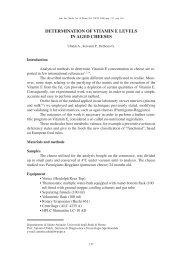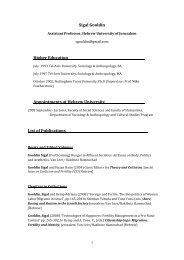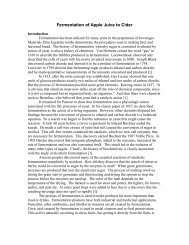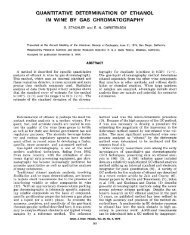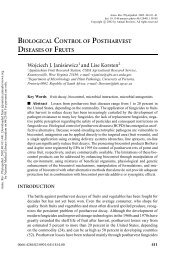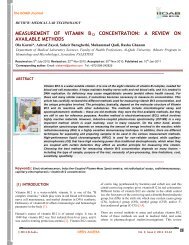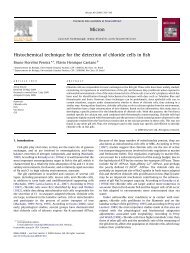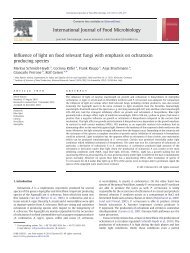On the gelling behaviour of 'nopal' (Opuntia ficus indica) low ...
On the gelling behaviour of 'nopal' (Opuntia ficus indica) low ...
On the gelling behaviour of 'nopal' (Opuntia ficus indica) low ...
Create successful ePaper yourself
Turn your PDF publications into a flip-book with our unique Google optimized e-Paper software.
Table 1<br />
Composition <strong>of</strong> <strong>Opuntia</strong> <strong>ficus</strong> <strong>indica</strong> pectin extract obtained by alkaline process with sodium hexametaphosphate as sequestering agent and with acid and<br />
o<strong>the</strong>r pectins<br />
Sample Extraction<br />
yield (w/w) a<br />
Protein b Ash b Fat b<br />
Intrinsic<br />
viscosity (ml/g) c<br />
Uronic acids b DE d Neutral sugars<br />
Rha b Ara b Gal b Glu b Xyl b<br />
Cactus pectin alkaline extract<br />
(this paper)<br />
0.6 N.D. N.D. N.D. 234 85.4 0 0.6 6 7 0 1<br />
Prickly pear peel pectin<br />
(acid process) e<br />
12.4 N.D. N.D. N.D. N.D. 64.5 N.D. 3.7 17.2 4 0 0.9<br />
Potato pulp (alkaline process) f<br />
20 6 10.2 0.8 N.D. 46.5 8.9 0.7 9.6 3.1 1.3 N.D.<br />
Commercial LM citrus pectin f a<br />
As % <strong>of</strong> dried raw biomass.<br />
N.D. 1.2 6.6 0.2 N.D. 41.2 18 0.7 0.3 1.4 1.9 N.D.<br />
b<br />
As % <strong>of</strong> dry weight <strong>of</strong> extract.<br />
c<br />
Determined in 0.1 M NaCl at 20 °C.<br />
d<br />
Degree <strong>of</strong> esterification calculated on <strong>the</strong> basis <strong>of</strong> galacturonic acid content.<br />
e<br />
Habibi et al. (1994).<br />
f<br />
Potato pulp pectin extracted with alkali with sodium hexametaphosphate and commercial citrus pectin (Turquois et al., 1999). N.D., not determined.<br />
& Vignon, 2004) as well as with potato pulp pectin<br />
obtained by <strong>the</strong> same extraction protocol using alkali and<br />
hexametaphosphate as sequestering agent and with those<br />
<strong>of</strong> a commercial LM citrus pectin. In general, <strong>the</strong> neutral<br />
sugars content <strong>of</strong> <strong>the</strong> studied pectin was <strong>low</strong>er than that<br />
reported for pectins sourced from prickly pear fruit peel<br />
and potato pulp. This, toge<strong>the</strong>r with <strong>the</strong> <strong>low</strong> rhamnose<br />
content, may suggest <strong>the</strong> existence <strong>of</strong> regions <strong>of</strong> long chains<br />
<strong>of</strong> polygalacturonate (homogalacturonan), which are<br />
essential for <strong>the</strong> <strong>gelling</strong> process, as it is fur<strong>the</strong>r discussed.<br />
While <strong>the</strong> content <strong>of</strong> uronic acids in cactus pectin was<br />
greater than that <strong>of</strong> prickly pear peel pectin obtained by<br />
an acidic process, it was roughly twice as high as that <strong>of</strong><br />
potato pulp and commercial LM citrus pectin. In general,<br />
<strong>the</strong> overall composition pr<strong>of</strong>ile <strong>of</strong> <strong>the</strong> cactus pectin composition<br />
coincides well with that <strong>of</strong> pectin obtained from<br />
lemon peel pectin (Ros, Schols, & Voragen, 1996) and<br />
sugar beet (Oosterveld et al., 2000; Turquois et al., 1999).<br />
The degree <strong>of</strong> esterification <strong>of</strong> <strong>the</strong> CPAE was investigated<br />
by FTIR spectroscopy. Fig. 1 shows <strong>the</strong> FTIR spec-<br />
Cactus pectin<br />
Citrus pectin<br />
4000 3500 3000 2500 2000 1500 1000 500 0<br />
Wavenumber (cm -1)<br />
Fig. 1. Absorbance spectra <strong>of</strong> FTIR spectroscopy for cactus pectin and<br />
commercial citrus pectin films obtained in transmission mode.<br />
A. Cárdenas et al. / Carbohydrate Polymers 73 (2008) 212–222 215<br />
trum <strong>of</strong> a CPAE film. Inspection <strong>of</strong> <strong>the</strong> spectral region<br />
between 1350 and 1750 cm 1 reveals <strong>the</strong> total absence <strong>of</strong><br />
<strong>the</strong> 1749 cm 1 band and <strong>the</strong> clear presence <strong>of</strong> two bands<br />
centered at 1625 and 1415 cm 1 . This result concords perfectly<br />
with <strong>the</strong> complete saponification <strong>of</strong> <strong>the</strong> methyl<br />
groups and <strong>the</strong> presence <strong>of</strong> <strong>the</strong> Na + form <strong>of</strong> <strong>the</strong> carboxylate<br />
groups pectin at <strong>the</strong> moment <strong>of</strong> film formation at a pH<br />
above <strong>the</strong> pKo <strong>of</strong> <strong>the</strong> carboxylic groups 3.3 (Milas &<br />
Rinaudo, 1997). The 1749 cm 1 band, assigned to C=O<br />
stretching vibrations <strong>of</strong> <strong>the</strong> non-ionized carboxylic groups,<br />
has been proposed as a probe to quantify <strong>the</strong> DE in pectin<br />
(Chatjigakis et al., 1998). The ionization (via salt formation)<br />
leads to its disappearance and to <strong>the</strong> appearance <strong>of</strong><br />
two new bands associated to symmetric and asymmetric<br />
COO stretching vibrations centered approximately at<br />
1600–1650 and 1400–1450 cm 1 , respectively (Kamnev,<br />
Colina, Rodríguez, Ptitchkina, & Ignatov, 1998). The high<br />
content <strong>of</strong> free carboxylic groups is directly related with <strong>the</strong><br />
alkaline conditions for pectin extraction. The purity <strong>of</strong> our<br />
CPAE material was not quantified, yet <strong>the</strong> protocol used to<br />
extract and purify <strong>the</strong> pectin polysaccharide was considered<br />
exhaustive enough so as to assure removal <strong>of</strong> most<br />
<strong>of</strong> mineral, protein and lipid impurities. Fresh cactus pads<br />
are known to contain 0.5–1% protein and 1–2% and ash in<br />
fresh weigh basis. The FTIR spectrum <strong>of</strong> CPAE does<br />
reveal <strong>the</strong> presence <strong>of</strong> some residual amount <strong>of</strong> protein as<br />
can be appreciated from <strong>the</strong> small shoulder at<br />
1550 cm 1 that can be assigned to amide II.<br />
13 C NMR spectroscopy confirmed <strong>the</strong> presence <strong>of</strong> two<br />
distinct types <strong>of</strong> materials in this cactus pectin. A major<br />
carbohydrate constituent that gives rise to six main C signals<br />
including <strong>the</strong> –C=O signal at 176.1 ppm characteristic<br />
<strong>of</strong> <strong>the</strong> uronic acid (Fig. 2), and a minor component to<br />
which also six carbon signals not well defined can be<br />
assigned. The integrals <strong>of</strong> <strong>the</strong> small signals relative to <strong>the</strong><br />
large signals one represent about 11.0% (w/w). It was gratifying<br />
to confirm that this value is in close agreement with<br />
that obtained for <strong>the</strong> proportion <strong>of</strong> neutral sugars obtained<br />
after complete hydrolysis. Hence, <strong>the</strong> large signals can be<br />
ascribed to poly-D-galacturonic acid, while small signals




